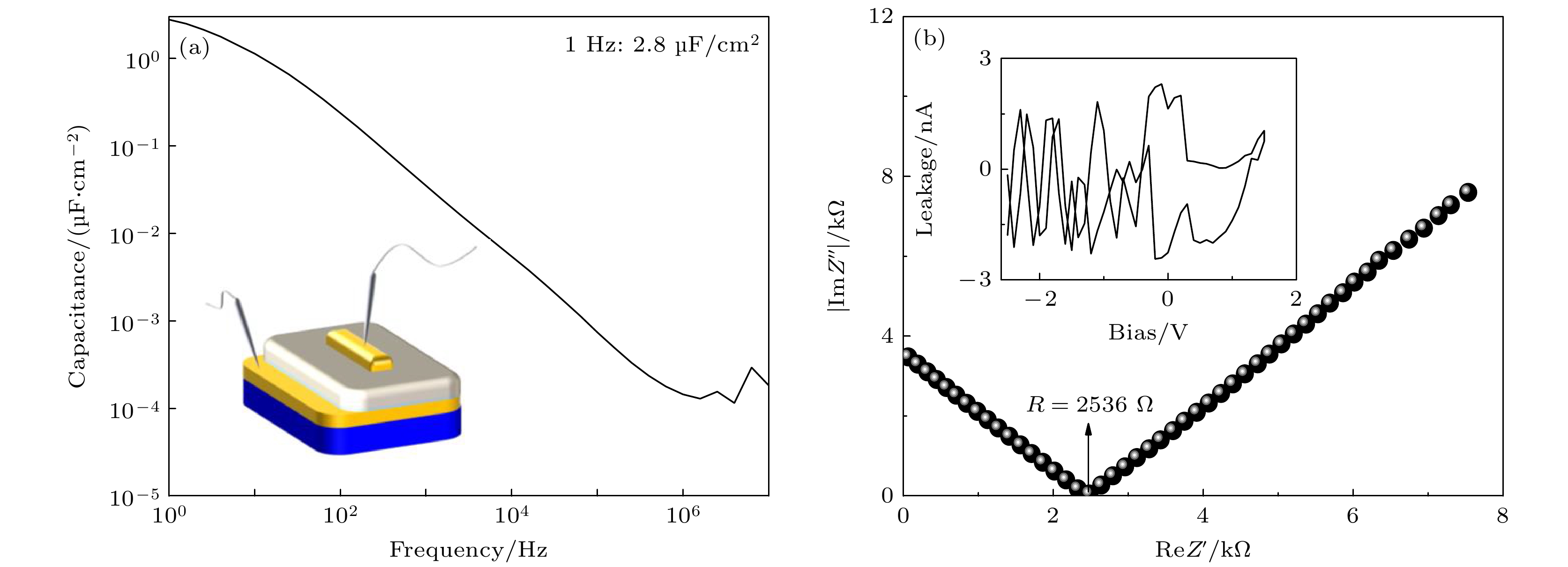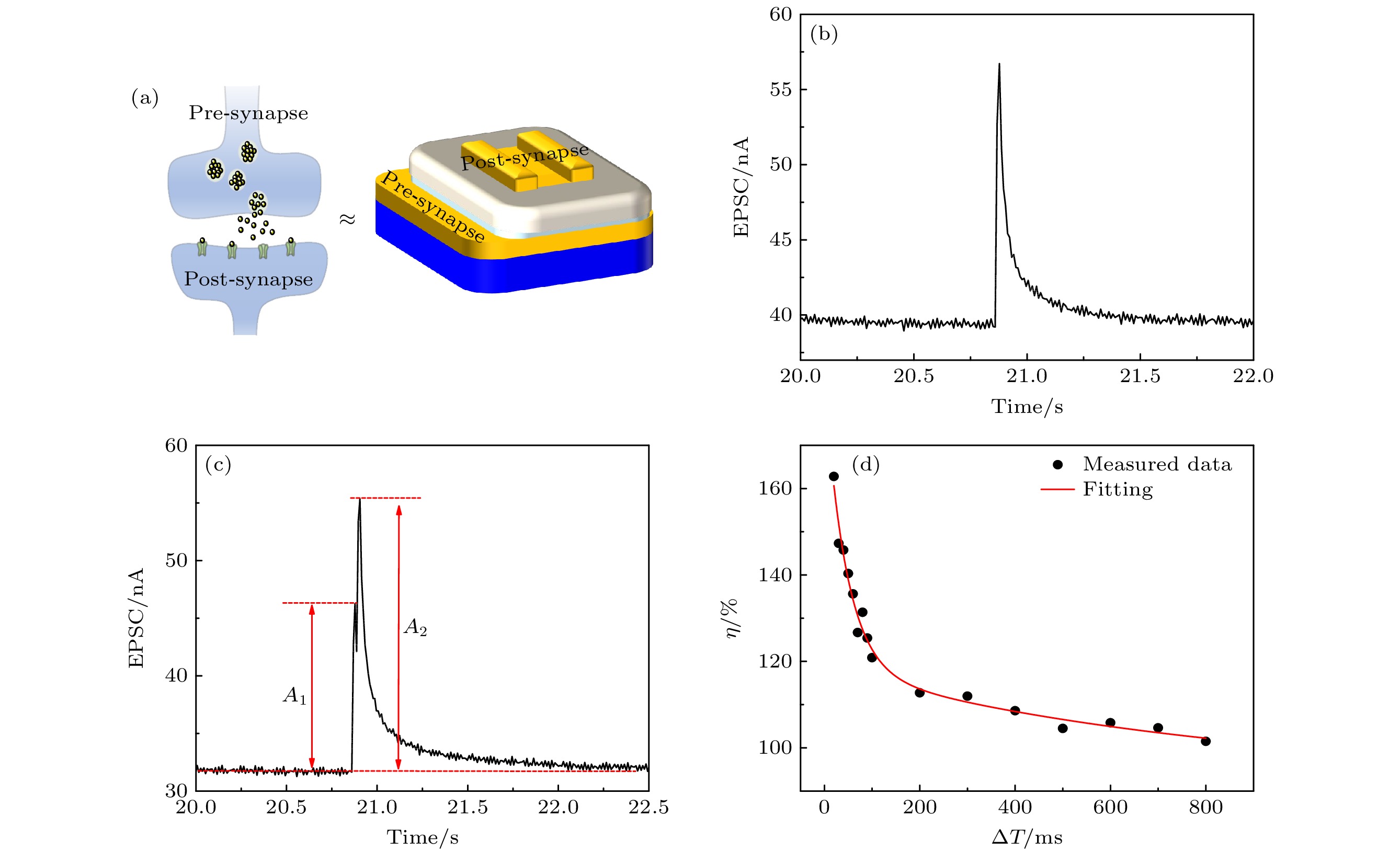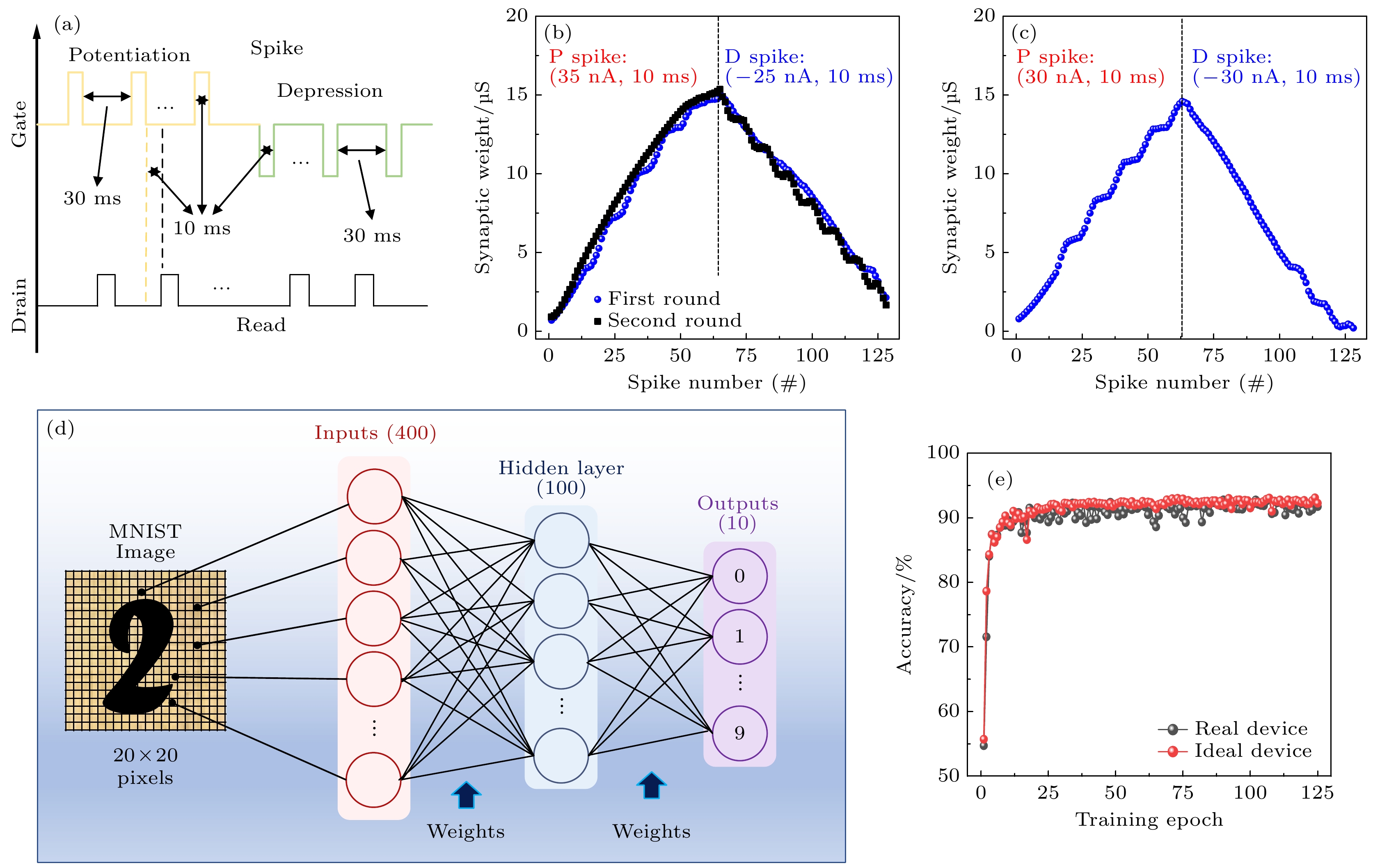-
近年来, 神经形态器件的研究受到了人们的广泛关注, 正在成为人工智能技术发展的重要分支. 与此同时, 天然生物材料具有可降解性、良好的生物相容性、无毒性等多种优势, 在新型便携式智能系统中有重要应用价值. 本文采用蛋壳膜(ESM)作为电解质, 具有极高的室温质子电导率(~6.4×10–3 S/cm)和极高的室温双电层电容(~2.8 µF/cm2), 因此其具有极强的界面双电层静电调控能力. 以此为基础, 研制了氧化铟锡双电层晶体管, 器件具有优异的电学特性. 基于ESM独特的界面双电层调控特性, 在器件上实现了一些重要仿生突触塑性行为, 如兴奋性突触后电流、双脉冲易化和突触滤波. 通过施加突触刺激, 实现了器件的多重突触权重更新. 在此基础上采用人工神经网络实现了手写数字的模式识别, 最佳识别精度约高达92.59%. 因此, 提出的ESM栅控氧化物神经形态晶体管在低成本生物可降解神经形态系统中有一定的应用潜力.
-
关键词:
- 蛋壳膜电解质 /
- 氧化物神经形态晶体管 /
- 突触塑性 /
- 模式识别
In recent years, the study of neuromorphic devices has received extensive attention. It is becoming an important branch of the development of artificial intelligence technology. At the same time, natural biomaterials have several priorities, such as biodegradability, good biocompatibility, and non-toxicity, and have important value in novel portable intelligent systems. The egg shell membrane (ESM) is a fiber scaffold composed of highly crosslinked collagen, glycoprotein and cysteine-rich eggshell membrane proteins. It has porous morphology, thermal stability, mechanical strength, etc. Therefore, these protein-based fiber membranes have several potential applications, including nanocatalysts, microbial fuel cells, and adsorption of toxic dyes. This study adopts ESM as electrolyte, exhibiting extremely high proton conductivity of about 6.4×10–3 S/cm and extremely high electric-double-layer (EDL) capacitance of about 2.8 µF/cm2 at room temperature. Thus, it has extremely strong interfacial EDL electrostatic modulation capability. Then, indium tin oxide EDL transistor is fabricated by using a single step masking processing and magnetron sputtering deposition technology. The device exhibits typical n-type output curves and transfer curves at low operating voltage. In addition, transfer curves are scanned twice. It is observed that the curves approach to each other quite well, indicating the good stabilities. Owing to the extremely strong proton gating effects, the device exhibits excellent electrical performances. Specifically, ON/OFF ratio, mobility and sub-threshold swing are estimated to be about 2.5×106, about 3.2 cm2/(V·s), and about 213 mV/dec, respectively. With the unique interfacial EDL modulation activities of ESM, the transistor can mimic some important synaptic plasticity behaviors, such as excitatory postsynaptic current (EPSC) and paired pulse facilitation (PPF). With the increase of pre-synaptic spike amplitude, the EPSC value increases correspondingly. With the increase of pre-synaptic spike frequency, the EPSC grain increases, indicating the potentials in high-pass synaptic filtering. By loading 64 potentiation spikes and 64 depression spikes, multi-level synaptic weight can be updated, demonstrating potentiation activity and depression activity. Again, with the same potentiation spikes and depression spikes, synaptic weight value curves approach to each other quite well, indicating that the present ESM gated oxide neuromorphic transistor has good stability. Then, an artificial neural network is adopted to perform supervised learning with Modified National Institute of Standards and Technology (MNIST) database. For simulation, a two-layer multilayer perceptron (MLP) neural network with 400 input neurons, 100 hidden neurons and 10 output neurons is adopted. The best recognition accuracy is as high as 92.59%. The proposed ESM gated oxide neuromorphic transistors have certain potentials in low-cost biodegradable neuromorphic systems.-
Keywords:
- egg shell membrane based electrolyte /
- oxide neuromorphic transistor /
- synaptic plasticity /
- pattern recognition
[1] Abbott L F, Regehr W G 2004 Nature 431 796
 Google Scholar
Google Scholar
[2] Poo M M, Du J L, Ip N Y, Xiong Z Q, Xu B, Tan T 2016 Neuron 92 591
 Google Scholar
Google Scholar
[3] James C D, Aimone J B, Miner N E, Vineyard C M, Rothganger F H, Carlson K D, Mulder S A, Draelos T J, Faust A, Marinella M J, Naegle J H, Plimpton S J 2017 Biol. Inspired Cognit. Archit. 19 49
[4] Zidan M A, Strachan J P, Lu W D 2018 Nat. Electron. 1 22
 Google Scholar
Google Scholar
[5] Jo S H, Chang T, Ebong I, Bhadviya B B, Mazumder P, Lu W 2010 Nano Lett. 10 1297
 Google Scholar
Google Scholar
[6] Kim M K, Lee J S 2018 ACS Nano 12 1680
 Google Scholar
Google Scholar
[7] Chen J B, Guo T T, Yang C Y, Xu J W, Gao L Y, Jia S J, Zhang P, Chen J T, Zhao Y, Wang J, Zhang X Q, Li Y 2023 J. Phys. Chem. C 127 3307
 Google Scholar
Google Scholar
[8] Zhu L Q, Wan C J, Guo L Q, Shi Y, Wan Q 2014 Nat. Commun. 5 3158
 Google Scholar
Google Scholar
[9] Ge C, Liu C X, Zhou Q L, Zhang Q H, Du J Y, Li J K, Wang C, Gu L, Yang G Z, Jin K J 2019 Adv. Mater. 31 1900379
 Google Scholar
Google Scholar
[10] Park H L, Kim H, Lim D, Zhou H, Kim Y H, Lee Y, Park S, Lee T W 2020 Adv. Mater. 32 1906899
 Google Scholar
Google Scholar
[11] Shao F, Feng P, Wan C J, Wan X, Yang Y, Shi Y, Wan Q 2017 Adv. Electron. Mater. 3 1600509
 Google Scholar
Google Scholar
[12] He Y L, Nie S, Liu R, Jiang S S, Shi Y, Wan Q 2019 Adv. Mater. 31 1900903
 Google Scholar
Google Scholar
[13] Feng G D, Jiang J, Li Y R, Xie D D, Tian B B, Wan Q 2021 Adv. Funct. Mater. 31 2104327
 Google Scholar
Google Scholar
[14] Guo Y B, Zhu L Q, Long T Y, Yun D, Ren Z Y 2020 J. Mater. Chem. C 8 2780
 Google Scholar
Google Scholar
[15] Fu Y M, Wan C J, Zhu L Q, Xiao H, Chen X D, Wan Q 2018 Adv. Biosyst. 2 1700198
 Google Scholar
Google Scholar
[16] Wang X J, Zhu L, Chen C S, Mao H W, Zhu Y X, Zhu Y, Yang Y, Wan C J, Wan Q 2021 Flexible. Printed Electron. 6 044008
 Google Scholar
Google Scholar
[17] Feng G D, Jiang J, Zhao Y H, Wang S T, Liu B, Yin K, Niu D M, Li X H, Chen Y Q, Duan H G 2020 Adv. Mater. 32 1906171
 Google Scholar
Google Scholar
[18] Zhong G K, Zi M F, Ren C L, Xiao Q, Tang M K, Wei L Y, An F, Xie S H, Wang J B, Zhong X L, Huang M Q, Li J Y 2020 Appl. Phys. Lett. 117 092903
 Google Scholar
Google Scholar
[19] Li L K, Wang X L, Pei J X, Liu W J, Wu X H, Zhang D W, Ding S J 2021 Sci. China Mater. 64 1219
 Google Scholar
Google Scholar
[20] Sangwan V K, Lee H S, Bergeron H, Balla I, Beck M E, Chen K S, Hersam M C 2018 Nature 554 500
 Google Scholar
Google Scholar
[21] Qiu W J, Sun J, Liu W R, Huang Y L, Chen Y, Yang J L, Gao Y L 2020 Org. Electron. 84 105810
 Google Scholar
Google Scholar
[22] Ding G L, Yang B D, Chen R S, Mo W A, Zhou K, Liu Y, Shang G, Zhai Y B, Han S T, Zhou Y 2021 Small 17 2103175
 Google Scholar
Google Scholar
[23] Li Y, Zhang C, Zhao X L, Tong Y H, Tang Q X, Liu Y C 2022 ACS Appl. Electron. Mater. 4 316
 Google Scholar
Google Scholar
[24] Raeis-Hosseini N, Park Y, Lee J S 2018 Adv. Funct Mater. 28 1800553
 Google Scholar
Google Scholar
[25] Guo L Q, Tao J, Zhu L Q, Xiao H, Gao W T, Yu F, Fu Y M 2018 Org. Electron. 61 312
 Google Scholar
Google Scholar
[26] He Y L, Nie S, Liu R, Shi Y, Wan Q 2019 IEEE Electron Device Lett. 40 139
 Google Scholar
Google Scholar
[27] Cai J C, Ren Z Y, Zhu L Q, Dai Y J, Zeng Y H, Guo W, Xiao H, Ye J C 2021 J. Phys. D-Appl. Phys. 54 375102
 Google Scholar
Google Scholar
[28] Wen J, Zhu L Q, Qi H F, Ren Z Y, Wang F, Xiao H 2020 Org. Electron. 82 105782
 Google Scholar
Google Scholar
[29] Jiang S H, Feng P, Yang Y, Du P F, Shi Y, Wan Q 2016 IEEE Electron Device Lett. 37 287
 Google Scholar
Google Scholar
[30] Li Z Y, Zhu L Q, Guo L Q, Ren Z Y, Xiao H, Cai J C 2021 ACS Appl. Mater. Interfaces 13 7784
 Google Scholar
Google Scholar
[31] Weymuth T, Jacob C R, Reiher M 2010 J. Phys. Chem. B 114 10649
 Google Scholar
Google Scholar
[32] Bandekar J 1992 Biochim. Biophys. Acta 1120 123
 Google Scholar
Google Scholar
[33] Dong Q, Su H L, Zhang D, Cao W, Wang N 2007 Langmuir 23 8108
 Google Scholar
Google Scholar
[34] Kong J, Yu S 2007 Acta Bioch. Bioph. Sin. 39 549
 Google Scholar
Google Scholar
[35] Arami M, Limaee N Y, Mahmoodi N M 2006 Chemosphere 65 1999
 Google Scholar
Google Scholar
[36] Fu Y M, Zhu L Q, Wen J, Xiao H, Liu R 2017 J. Appl. Phys. 121 205301
 Google Scholar
Google Scholar
[37] Mukhamedyarov M A, Grishin S N, Zefirov A L, Palotas A 2009 Pflugers Arch. -Eur. J. Physiol 458 563
 Google Scholar
Google Scholar
[38] Chen P Y, Peng X C, Yu S M 2018 IEEE Trans. Comput. -Aided Design Integr. Circuits Syst. 37 3067
 Google Scholar
Google Scholar
[39] Wang W S, Ren Z Y, Shi Z W, Xiao H, Zeng Y H, Zhu L Q 2022 IEEE Electron Device Lett. 43 737
 Google Scholar
Google Scholar
-
图 1 (a) ESM电解质膜栅控ITO神经形态晶体管的制备流程示意图, 插图是器件的照片; (b) 鸡蛋壳内ESM内外双层分层情况照片; (c) ESM内膜内表面的SEM显微形貌照片; (d) ESM内膜外表面的SEM显微形貌照片; (e) ESM膜的截面SEM照片; (f) ESM膜的傅里叶变换红外光谱(FTIR)
Fig. 1. (a) Device processing of ESM electrolyte gated ITO neuromoprhic transistor; Inset: photograph of device; (b) photograph of ESM double layer in egg shell; (c) SEM morphology image of ESM inner membrane inner surface; (d) SEM morphology image of ESM inner membrane outer surface; (e) SEM cross sectional image of ESM inner membrane; (f) Fourier transform infrared spectroscopy of ESM.
图 4 (a) 生物突触结构(左)及ITO神经形态晶体管(右)示意图; (b) 典型的EPSC响应, 读取电压Vds = 0.5 V, 前突触刺激为(1 V, 10 ms); (c) 两个前突触刺激下的EPSC响应, 前突触刺激为(1 V, 10 ms), 间隔时间∆t = 20 ms; (d) η随Δt的变化关系
Fig. 4. (a) Schematic diagram of a synapse (left) and ITO neuromorphic transistor (right); (b) typical EPSC response triggered with a presynaptic spike (1 V, 10 ms), Vds = 0.5 V; (c) EPSC response triggered with paired presynaptic spikes (1 V, 10 ms), interval time Δt = 20 ms; (d) η as a function of Δt value.
图 5 (a) 不同刺激强度下的EPSC相应; (b) 不同频率刺激序列下的EPSC响应; (c) 高通滤波功能示意图; (d) EPSC幅值增益与刺激频率的关系.
Fig. 5. (a) EPSC responses under different presynaptic spike amplitude; (b) EPSC responses under spike trains with different frequency; (c) schematic diagram of high-pass filtering; (d) EPSC grain as a function of spike frequency.
图 6 (a) 施加在ITO神经形态晶体管上的刺激信号示意图; (b), (c) 不同增强脉冲和抑制脉冲刺激下的权重更新结果; (d) 两层MLP模拟器的示意图, 由400个输入神经元、100个隐藏神经元和10个输出神经元组成; (e) MNIST识别精度
Fig. 6. (a) Schematic diagram of spike loaded on ITO neuromorphic transistor; (b) and (c) synaptic weight updating obtained under different potentiation/depression spikes; (d) schematic diagram of two-layer MLP simulator, consisting of 400 input neurons, 100 hidden neurons and 10 output neurons; (e) recognition accuracies for MNIST patterns.
-
[1] Abbott L F, Regehr W G 2004 Nature 431 796
 Google Scholar
Google Scholar
[2] Poo M M, Du J L, Ip N Y, Xiong Z Q, Xu B, Tan T 2016 Neuron 92 591
 Google Scholar
Google Scholar
[3] James C D, Aimone J B, Miner N E, Vineyard C M, Rothganger F H, Carlson K D, Mulder S A, Draelos T J, Faust A, Marinella M J, Naegle J H, Plimpton S J 2017 Biol. Inspired Cognit. Archit. 19 49
[4] Zidan M A, Strachan J P, Lu W D 2018 Nat. Electron. 1 22
 Google Scholar
Google Scholar
[5] Jo S H, Chang T, Ebong I, Bhadviya B B, Mazumder P, Lu W 2010 Nano Lett. 10 1297
 Google Scholar
Google Scholar
[6] Kim M K, Lee J S 2018 ACS Nano 12 1680
 Google Scholar
Google Scholar
[7] Chen J B, Guo T T, Yang C Y, Xu J W, Gao L Y, Jia S J, Zhang P, Chen J T, Zhao Y, Wang J, Zhang X Q, Li Y 2023 J. Phys. Chem. C 127 3307
 Google Scholar
Google Scholar
[8] Zhu L Q, Wan C J, Guo L Q, Shi Y, Wan Q 2014 Nat. Commun. 5 3158
 Google Scholar
Google Scholar
[9] Ge C, Liu C X, Zhou Q L, Zhang Q H, Du J Y, Li J K, Wang C, Gu L, Yang G Z, Jin K J 2019 Adv. Mater. 31 1900379
 Google Scholar
Google Scholar
[10] Park H L, Kim H, Lim D, Zhou H, Kim Y H, Lee Y, Park S, Lee T W 2020 Adv. Mater. 32 1906899
 Google Scholar
Google Scholar
[11] Shao F, Feng P, Wan C J, Wan X, Yang Y, Shi Y, Wan Q 2017 Adv. Electron. Mater. 3 1600509
 Google Scholar
Google Scholar
[12] He Y L, Nie S, Liu R, Jiang S S, Shi Y, Wan Q 2019 Adv. Mater. 31 1900903
 Google Scholar
Google Scholar
[13] Feng G D, Jiang J, Li Y R, Xie D D, Tian B B, Wan Q 2021 Adv. Funct. Mater. 31 2104327
 Google Scholar
Google Scholar
[14] Guo Y B, Zhu L Q, Long T Y, Yun D, Ren Z Y 2020 J. Mater. Chem. C 8 2780
 Google Scholar
Google Scholar
[15] Fu Y M, Wan C J, Zhu L Q, Xiao H, Chen X D, Wan Q 2018 Adv. Biosyst. 2 1700198
 Google Scholar
Google Scholar
[16] Wang X J, Zhu L, Chen C S, Mao H W, Zhu Y X, Zhu Y, Yang Y, Wan C J, Wan Q 2021 Flexible. Printed Electron. 6 044008
 Google Scholar
Google Scholar
[17] Feng G D, Jiang J, Zhao Y H, Wang S T, Liu B, Yin K, Niu D M, Li X H, Chen Y Q, Duan H G 2020 Adv. Mater. 32 1906171
 Google Scholar
Google Scholar
[18] Zhong G K, Zi M F, Ren C L, Xiao Q, Tang M K, Wei L Y, An F, Xie S H, Wang J B, Zhong X L, Huang M Q, Li J Y 2020 Appl. Phys. Lett. 117 092903
 Google Scholar
Google Scholar
[19] Li L K, Wang X L, Pei J X, Liu W J, Wu X H, Zhang D W, Ding S J 2021 Sci. China Mater. 64 1219
 Google Scholar
Google Scholar
[20] Sangwan V K, Lee H S, Bergeron H, Balla I, Beck M E, Chen K S, Hersam M C 2018 Nature 554 500
 Google Scholar
Google Scholar
[21] Qiu W J, Sun J, Liu W R, Huang Y L, Chen Y, Yang J L, Gao Y L 2020 Org. Electron. 84 105810
 Google Scholar
Google Scholar
[22] Ding G L, Yang B D, Chen R S, Mo W A, Zhou K, Liu Y, Shang G, Zhai Y B, Han S T, Zhou Y 2021 Small 17 2103175
 Google Scholar
Google Scholar
[23] Li Y, Zhang C, Zhao X L, Tong Y H, Tang Q X, Liu Y C 2022 ACS Appl. Electron. Mater. 4 316
 Google Scholar
Google Scholar
[24] Raeis-Hosseini N, Park Y, Lee J S 2018 Adv. Funct Mater. 28 1800553
 Google Scholar
Google Scholar
[25] Guo L Q, Tao J, Zhu L Q, Xiao H, Gao W T, Yu F, Fu Y M 2018 Org. Electron. 61 312
 Google Scholar
Google Scholar
[26] He Y L, Nie S, Liu R, Shi Y, Wan Q 2019 IEEE Electron Device Lett. 40 139
 Google Scholar
Google Scholar
[27] Cai J C, Ren Z Y, Zhu L Q, Dai Y J, Zeng Y H, Guo W, Xiao H, Ye J C 2021 J. Phys. D-Appl. Phys. 54 375102
 Google Scholar
Google Scholar
[28] Wen J, Zhu L Q, Qi H F, Ren Z Y, Wang F, Xiao H 2020 Org. Electron. 82 105782
 Google Scholar
Google Scholar
[29] Jiang S H, Feng P, Yang Y, Du P F, Shi Y, Wan Q 2016 IEEE Electron Device Lett. 37 287
 Google Scholar
Google Scholar
[30] Li Z Y, Zhu L Q, Guo L Q, Ren Z Y, Xiao H, Cai J C 2021 ACS Appl. Mater. Interfaces 13 7784
 Google Scholar
Google Scholar
[31] Weymuth T, Jacob C R, Reiher M 2010 J. Phys. Chem. B 114 10649
 Google Scholar
Google Scholar
[32] Bandekar J 1992 Biochim. Biophys. Acta 1120 123
 Google Scholar
Google Scholar
[33] Dong Q, Su H L, Zhang D, Cao W, Wang N 2007 Langmuir 23 8108
 Google Scholar
Google Scholar
[34] Kong J, Yu S 2007 Acta Bioch. Bioph. Sin. 39 549
 Google Scholar
Google Scholar
[35] Arami M, Limaee N Y, Mahmoodi N M 2006 Chemosphere 65 1999
 Google Scholar
Google Scholar
[36] Fu Y M, Zhu L Q, Wen J, Xiao H, Liu R 2017 J. Appl. Phys. 121 205301
 Google Scholar
Google Scholar
[37] Mukhamedyarov M A, Grishin S N, Zefirov A L, Palotas A 2009 Pflugers Arch. -Eur. J. Physiol 458 563
 Google Scholar
Google Scholar
[38] Chen P Y, Peng X C, Yu S M 2018 IEEE Trans. Comput. -Aided Design Integr. Circuits Syst. 37 3067
 Google Scholar
Google Scholar
[39] Wang W S, Ren Z Y, Shi Z W, Xiao H, Zeng Y H, Zhu L Q 2022 IEEE Electron Device Lett. 43 737
 Google Scholar
Google Scholar
计量
- 文章访问数: 6264
- PDF下载量: 120
- 被引次数: 0














 下载:
下载:





